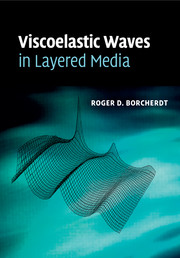Book contents
- Frontmatter
- Contents
- Preface
- 1 One-Dimensional Viscoelasticity
- 2 Three-Dimensional Viscoelasticity
- 3 Viscoelastic P, SI, and SII Waves
- 4 Framework for Single-Boundary Reflection–Refraction and Surface-Wave Problems
- 5 General P, SI, and SII Waves Incident on a Viscoelastic Boundary
- 6 Numerical Models for General Waves Reflected and Refracted at Viscoelastic Boundaries
- 7 General SI, P, and SII Waves Incident on a Viscoelastic Free Surface
- 8 Rayleigh-Type Surface Wave on a Viscoelastic Half Space
- 9 General SII Waves Incident on Multiple Layers of Viscoelastic Media
- 10 Love-Type Surface Waves in Multilayered Viscoelastic Media
- 11 Appendices
- References
- Additional Reading
- Index
4 - Framework for Single-Boundary Reflection–Refraction and Surface-Wave Problems
Published online by Cambridge University Press: 29 October 2009
- Frontmatter
- Contents
- Preface
- 1 One-Dimensional Viscoelasticity
- 2 Three-Dimensional Viscoelasticity
- 3 Viscoelastic P, SI, and SII Waves
- 4 Framework for Single-Boundary Reflection–Refraction and Surface-Wave Problems
- 5 General P, SI, and SII Waves Incident on a Viscoelastic Boundary
- 6 Numerical Models for General Waves Reflected and Refracted at Viscoelastic Boundaries
- 7 General SI, P, and SII Waves Incident on a Viscoelastic Free Surface
- 8 Rayleigh-Type Surface Wave on a Viscoelastic Half Space
- 9 General SII Waves Incident on Multiple Layers of Viscoelastic Media
- 10 Love-Type Surface Waves in Multilayered Viscoelastic Media
- 11 Appendices
- References
- Additional Reading
- Index
Summary
Analytic closed-form solutions for problems of body- and surface-wave propagation in layered viscoelastic media will show that the waves in anelastic media are predominantly inhomogeneous with the degree of inhomogeneity dependent on angle of incidence and intrinsic absorption. Hence, it is reasonable to expect from results in the previous chapter that the physical characteristics of refracted waves in layered anelastic media also will vary with the angle of incidence and be dependent on the previous travel path of the wave. These concepts are not encountered for waves in elastic media, because the waves traveling through a stack of layers are homogeneous with their physical characteristics such as phase speed not dependent on the angle of incidence. This chapter will provide the framework and solutions for each of the waves needed to derive analytic solutions for various reflection–refraction and surface-wave problems in subsequent chapters.
Specification of Boundary
To set up the mathematical framework for considering reflection–refraction problems at a single viscoelastic boundary and surface-wave problems, consider two infinite HILV media denoted by V and V′ with a common plane boundary in welded contact (Figure (4.1.3)). For reference, the locations of the media are described by a rectangular coordinate system specified by coordinates (x1, x2, x3) or (x, y, z) with the space occupied by V described by x3 > 0, the space occupied by V′ by x3 > 0, and the plane boundary by x3 = 0. For problems involving a viscoelastic half space V′ will be considered a vacuum.
Information
- Type
- Chapter
- Information
- Viscoelastic Waves in Layered Media , pp. 98 - 106Publisher: Cambridge University PressPrint publication year: 2009
